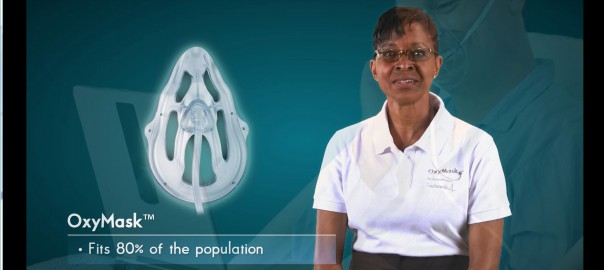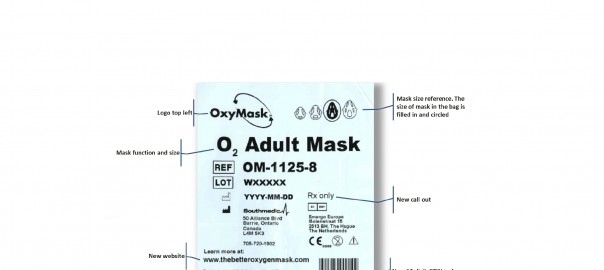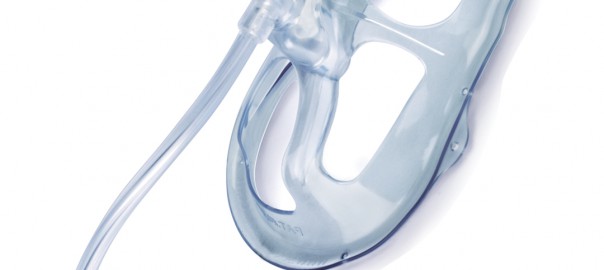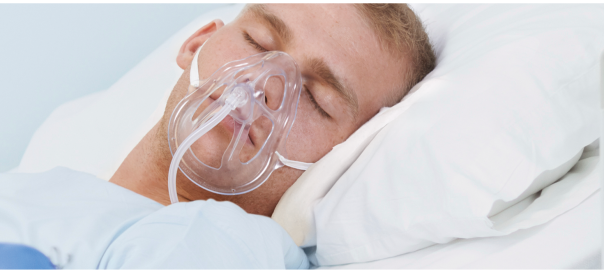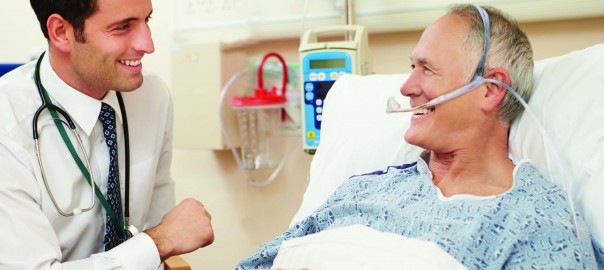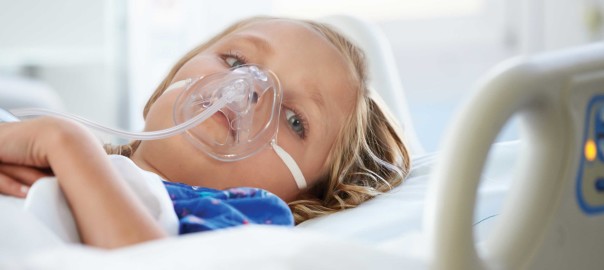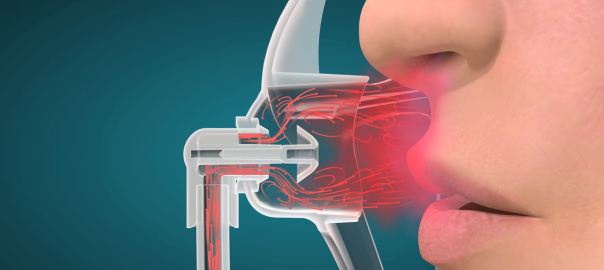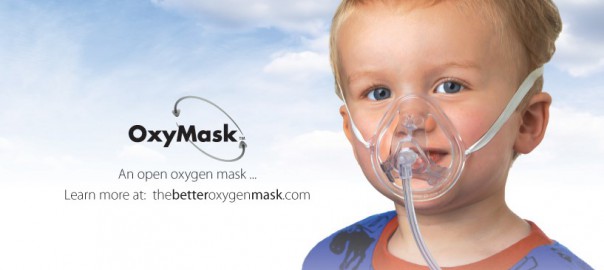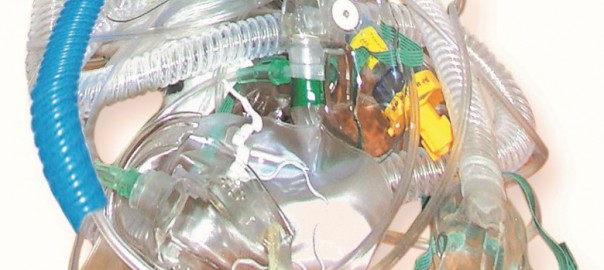New educational tools are now available https://thebetteroxygenmask.com/clinical-education/. There are three new in service videos, handouts, online quiz, and more! Contact our sales and marketing department for support on your next training sessions at oxymask@southmedic.com.
OxyMask™ News
OxyMask is getting new packaging! The new packaging is colour coded so choosing the correct size can be done quickly. All sizes available are illustrated in the top right corner. Size and functionality of mask is clearly described.
Respiratory Therapists play a significant role in the health and wellbeing of their patients. They are responsible for making sure patients are comfortable, safe and compliant with oxygen therapy and are dedicated to helping them benefit from treatment. When treating patients on oxygen therapy, many RT’s are challenged with finding the most appropriate oxygen therapy device to best suit their needs. Why RTs choose OxyMask … OxyMask is one of the latest breakthroughs in advanced oxygen delivery technology. It features an open design that is ideal for patients whose oxygen requirements vary throughout their hospital stay. Clinicians can respond to a patient’s changing oxygen needs simply by increasing or decreasing oxygen meter flow from 1 litre per minute (lpm) up to flush (>15 lpm) to deliver 24%-90% FiO2 and maintain the desired SpO2. OxyMask is designed to deliver a broad range of oxygen in a safe and effective manner. OxyMask is the ideal solution many of the issues RTs are faced with today. Read more about the features and benefits of OxyMask -> LEARN MORE
The primary factor of oxygen therapy success is if patients are compliant with their prescribed care plan. Oxygen therapy compliance can help patients avoid hospitalization. Patients are often not compliant with their oxygen therapy because: They start to feel better, and they discontinue their therapy They are not confident on how to use the equipment properly The oxygen therapy device is uncomfortable Skin irritation occurs after prolonged usage RTs can help patients adhere to their oxygen therapy treatments by: Educating patients and their families about what is required and why Ensure patients are confident in how to use the equipment Frequently checking in on patients to ensure oxygen therapy is being used safely and correctly Finding the most appropriate interface to best suit each patient individually Oxygen therapy is an essential part of respiratory care and is used as a medical treatment in both acute and chronic care settings. It is a fundamental treatment strategy for the majority of respiratory patients and is crucial to maintaining adequate cardiopulmonary health. It is the primary role of RT’s to make sure patients and their families are aware of the benefits of therapy as well as the risks associated with non-compliance.
Comfort is one of the most fundamental aspects of basic human necessity. It is an influential part of our daily decision making and is vital to the health and well being of every patient. Respiratory Therapists play an important role in providing a sense of safety and security for patients and their families, and are helpful in providing comfort in challenging situations. Along with other members of the health care team, RT’s are responsible for the physical and mental wellbeing of their patients and are dedicated to quality patient care and comfort. For an RT, making patients feel secure and limiting physical discomfort is a top priority. For example, homecare users may find that their nasal cannulas irritate their nose, or in the hospital, traditional closed masks can be humid, noisy and muffle communication. RTs are challenged to find ways to make oxygen therapy more comfortable as physical comfort is an essential part of patient compliance. For many patients, falling sick and seeking medical attention can be an unfamiliar and intimidating experience. It is up to their healthcare team to provide a safe and comfortable experience. Read how OxyMask is helping patients become more comfortable with their oxygen therapy inRead More…
Patient safety is the most important consideration in respiratory care and should always be in the forefront of each decision made by the practitioner. It is the responsibility of the RT to ensure the care given to their patients follows the legal and ethical principles as mandated by their regulatory college. It is the RT’s obligation to avoid harm from coming to their patients while actively contributing to their health and wellbeing. It goes without saying that patient safety and quality care should be top priority for any healthcare practitioner. Every RT is dedicated to providing safe and effective care alongside doctors, nurses and other members of the healthcare team with a common goal of providing positive patient outcomes. Their responsibilities for patient safety include, but are not limited to, assessing the patients oxygen needs, choosing the correct respiratory therapy devices, setting oxygen flow and maintaining prescribed saturation. Continual assessment is required as patients oxygen needs fluctuate. As new respiratory products are introduced, RTs are challenged to stay up to date on what products are out there to help them keep patients safe.
This respiratory care week, OxyMask will be exploring the role of the respiratory therapist. We will be posting daily topics on RTs. Starting with, how RTs help. Helping patients is the foundation to all respiratory practices and is one of the most important principles of respiratory care. Whether the RT is simply initiating low flow oxygen therapy, providing education on smoking cessation or assisting in a cardiac arrest, they are always committed to providing optimal care and are dedicated to helping their patient’s breath better. We have all, at one point or another experienced some degree of respiratory distress. Whether it be the familiar “huff and puff” from walking up a flight of stairs or coughing up an alarming amount of suspicious green phlegm from a flu bug that lingered a week too long; We have all felt the effects of increased work on our respiratory systems. It is the role of the RT to help patient’s understand their disease processes and to provide support, education and optimal care along the way. They are involved in helping diagnose, control and treat any underlying respiratory conditions in patients with breathing difficulties and are responsible for promoting continuity of care for patientsRead More…
OxyMask’s ability to maintain a concentrated flow of oxygen means that less oxygen flow is required to maintain a prescribed SpO2. To the hospital and to the ambulance this means patient safety and cost savings. OxyMask provides a targeted, concentrated flow of oxygen directed towards the mouth and nose. This ‘virtual reservoir’ of concentrated oxygen maintains the prescribed SpO2 saturation levels while utilizing less oxygen flow. Less oxygen is needed when using OxyMask compared to traditional masks to achieve the same clinical result. Decreased work of breathing is accomplished as the OxyMask wearer has direct access to an immediate concentration of oxygen without the need to open a valve or draw from a reservoir bag. Oxygen is conserved as a specific volume of gas is not required to maintain a concentration or flush out mask dead space. By delivering only the patient’s required amount of oxygen at lower flows, total oxygen consumption is reduced. OxyMask’s ability to target and deliver oxygen flow at the area of utilization results in better clinical results and oxygen gas savings. This can have a significant positive impact on a hospital’s oxygen budget. In addition OxyMask provides greater safety for rotary, fixed wing, andRead More…
We have a new white paper! Using the link below, read how OxyMask™ is one of the latest breakthroughs in advanced oxygen delivery technology. http://www.rtmagazine.com/2016/09/white-paper-oxymask-advancing-oxygen-therapy-better-patient-care/
Few people can say they don’t have that dreaded junk drawer, storage closet, or garage they feel overwhelmed to tackle. They are full of things “we just didn’t know what to do with”, “might need later”, or “cost a lot of money at the time.” Clutter, unfortunately, is part of our daily lives. But countless studies show that clutter leads to increased stress, further disorganization and distractions. This often translates to the workplace. In healthcare, clutter is everywhere. In a rapidly changing field there is always the latest best practice or equipment that is promoted. This ranges from equipment costing thousands of dollars to a small box of disposable goods. Seldom is there time allotted for cleanup and decluttering. Many issues can arise from medical clutter. Here is a couple of the issues, causes and possible solutions: Issue Clutter Cause Possible Solutions Increased errors in treatment When distracted by clutter you may make mistakes Re-evaluate and remove products that are obsolete Consider using products that serve more than one purpose and or replace multiple products Assign front line staff to keep clutter from getting out of control Increased incidence of both patient and staff injury Cluttered areas areRead More…
